For decades, former employees and vendors of US president Donald Trump’s hotels and casinos have accused him of not honoring his obligations and stiffing them on unpaid bills and wages.
Apparently, Trump knows how they feel. Accusing Chinese officials of not honoring the terms of a trade agreement, the president today announced a new 10% tariff on $300 billion of Chinese imports not already covered by previous rounds of tariffs. While it’s not at the 25% level once threatened, the new levy—which goes into effect Sept. 1—should ensure virtually every good produced in China will cost more in the US. It’s not clear how China will respond, but retaliation seems likely.
The new tariffs will strike a wide swath of consumer goods, including toys, sports equipment, household electronics, and clothing. Investors, not happy about the prospect of holiday-season shoppers paying more for presents, responded by dumping shares of retailers most likely to feel the sting. Apple, Gap, and Best Buy all fell on the news.
The announcement comes a day after Federal Reserve chair Jerome Powell cited ongoing trade tensions as justification for the Fed’s first interest rate cut in a decade. Investors, who’d been hoping for a more positive signal, sold off shares based on the gloomy messaging (and Powell’s declaration no other cuts were planned), and today’s move is unlikely to buoy them.
As with many administration decisions, it’s hard to divine whether the new tariffs are part of a broader negotiating strategy, or just a fit of pique from a president who felt he didn’t get what he was promised. In a series of tweets, Trump accused China of reneging on an agreement to buy US agricultural goods and of failing to block the flow of the drug fentanyl into the US.
Whatever the motivations, the new tariffs are sure to slow growth not just in the US, but around the world. The OECD forecasts global trade falling 1.6% and global growth slowing 0.7% in a worst-case tariff scenario of mutual 25% tariffs on all goods traded between the US and China. We’re not there yet, but it’s not hard to see where this is heading.
